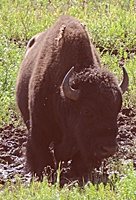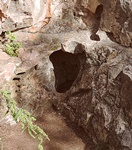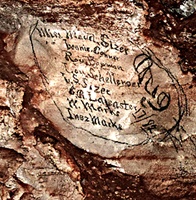This morning is beautiful and almost no rain in the past 24 hours! Looking forward to a great week for Independence Day this week. Forecast says nice weather up thrpugh the weekend, with some chance of showers this Tuesday. Now all we need is for it to really be that way!
 This past week we returned to Wind Cave NP and did a cave tour to pretty much complete our investigation of that park Wind Cave NP is
This past week we returned to Wind Cave NP and did a cave tour to pretty much complete our investigation of that park Wind Cave NP is  actually quite large with significant wildlife populations. You see a lot of buffalo, although not the large heards of Custer State Park. They are scattered or in small groups but are very common. For some reason they seem to be mostly males with very few cow/calf pairs. They do appear to be in a more natural setting since they are not handled regularly as the ones in Custer park are.
actually quite large with significant wildlife populations. You see a lot of buffalo, although not the large heards of Custer State Park. They are scattered or in small groups but are very common. For some reason they seem to be mostly males with very few cow/calf pairs. They do appear to be in a more natural setting since they are not handled regularly as the ones in Custer park are.
Another animal that is frequently seen if you watch closely is the pronghorn antelope. They are quite scattered at this time of the year as they only tend to heard up in fall and winter and fawns are fairly common. Both does & bucks have horns but those of the buck are much more impressive and have a branch that the does do not have. Early morning or late evening are the best times to see wildlife and particularly the pronghorn. In addition it is very common to see prairiedogs and coyotes are not unusual if you watch at a distance. There are also elk in the park but not nearly so many as other animals and so they are not often seen.
 Of course the main attraction of this park is the cave tours. There are four different tous available and the challenging one is all day and
Of course the main attraction of this park is the cave tours. There are four different tous available and the challenging one is all day and  you wear a helmet and headlamp as well as knee pads. It is not for the faint of heart, nor for us either! The tour that we did take lasted about 1 1/2 hours and was entry and exit by the elevator. Not far from the visitor center is the natural entrance and you can & should see it. It is hard to imagine that the first explorers crawled in through that hole which is only about 10" by 18" and you can't see much of anything inside. The reason for the name of the cave is that with air pressure changes due to weather, air goes into or out of the cave and with a very large cave and a small entrance, it blows through that hole at rates between 10 & 35 mph. It is said that the discovery came because the wind from the cave blew the hat off of the fellow and when he returned later to show a friend it had reversed and sucked his hat into the cave and out of sight!
you wear a helmet and headlamp as well as knee pads. It is not for the faint of heart, nor for us either! The tour that we did take lasted about 1 1/2 hours and was entry and exit by the elevator. Not far from the visitor center is the natural entrance and you can & should see it. It is hard to imagine that the first explorers crawled in through that hole which is only about 10" by 18" and you can't see much of anything inside. The reason for the name of the cave is that with air pressure changes due to weather, air goes into or out of the cave and with a very large cave and a small entrance, it blows through that hole at rates between 10 & 35 mph. It is said that the discovery came because the wind from the cave blew the hat off of the fellow and when he returned later to show a friend it had reversed and sucked his hat into the cave and out of sight!
 Like most caves, this one has many interesting and beautiful formations but the one most uniqueto this particular cave is a formation called boxwork. This is the only place that I can recall ever having seen this type of thing. It is found in numerous places through the cave and all tours will see it. There is also an
Like most caves, this one has many interesting and beautiful formations but the one most uniqueto this particular cave is a formation called boxwork. This is the only place that I can recall ever having seen this type of thing. It is found in numerous places through the cave and all tours will see it. There is also an  area where there is a lot of graffit from the early years of the cave visitation. It is interesting in it's historic nature, but of course is no longer allowed to be done. The visitor center has some very good displays of the history of the cave and of the local area as well as about those who found and explored it. Wind Cave was the first national park developed in order to protect a cave and make it available to the public. For some years it had commercial tours and was under private ownership. The cave has more than 196 miles of known passageways and nearly all of those are under about 1 square mile of surface area.
area where there is a lot of graffit from the early years of the cave visitation. It is interesting in it's historic nature, but of course is no longer allowed to be done. The visitor center has some very good displays of the history of the cave and of the local area as well as about those who found and explored it. Wind Cave was the first national park developed in order to protect a cave and make it available to the public. For some years it had commercial tours and was under private ownership. The cave has more than 196 miles of known passageways and nearly all of those are under about 1 square mile of surface area.







